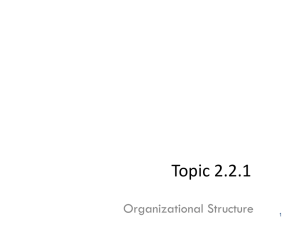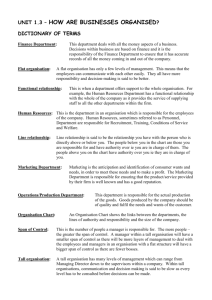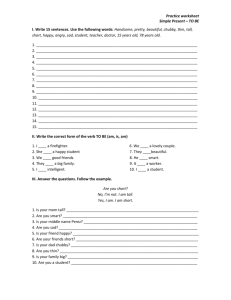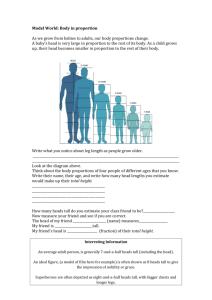Organisational structures
advertisement
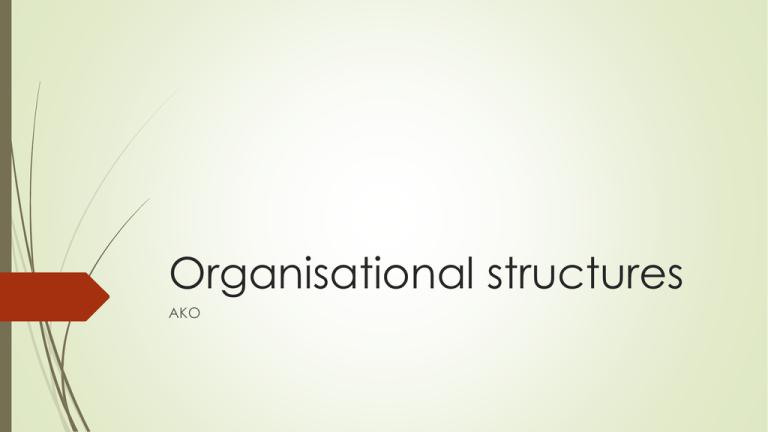
Organisational structures AKO Types of structures The structure of business organizations can be described as either tall or flat. This refers to the levels of management in the organization's hierarchy and the corresponding distance between front-line or entry-level employees and top management. Whether a business has a tall or a flat structure can have important impacts on a variety of elements within the organizational cutlure. Span of Control In contrast to a tall organisation, a flat organisation will have relatively few layers or just one layer of management. This means that the “Chain of Command” from top to bottom is short and the “span of control is wide”. Span of control refers to the number of employees that each manager is responsible for. If a manager has lots of employees reporting to them, their span of control is said to be wide. A manager with a small number of direct reports has a narrow span of control. Due to the small number of management layers, flat organisations are often small organisations. Flat structure Flat structures have fewer management levels. These structures are more common in smaller businesses. Focus is on empowering employees rather than focusing on a chain of command. Often lead to more creative and innovated employees. Communication is more quick and easy. Tall structure Often require a heirachy system. Basically in simplest form, a chain of command. As an organisation grows, the longer the chain will get. Managers will delegate into separate segments of the company (marketing, accounting, legal etc) Narrow span of control allows for closer supervision of staff Difference Layers of Management The difference between tall and flat organizational structures is the layers of management. In a flat organizational structure. There may be just one top manager who is an owner or CEO of the company, overseeing a handful of other employees, all with equal levels of authority. In a tall organizational structure, by contrast, there are multiple layers of authority between the CEO and low-level employees. For example, an entry-level employee may report to a supervisor, who reports to a manager, who reports to a director, who reports to a vice president, who, finally, reports to top management. Employee Motivation Employee motivation is a key factor in any organizational structure. While employees in a flat organization may feel as though they have more direct influence on the company, they may also feel as though they have no room for advancement. On the other hand, employees at a tall organization have many layers through which to advance their careers, but may become frustrated at their relative lack of influence at lower levels within the company. Difference - continued Organizational Complexity Generally, the more complex an organization becomes, the taller the organization must be. An employee in a small organization may be able to handle all the company's marketing duties; however, as the organization grows, that employee may need subordinates to whom he can delegate certain tasks. Additionally, top managers can generally be much more effective if they have a handful of upper-level managers reporting to them, as opposed to dozens or more of lower-level employees. Flexibility One advantage a flat organizational structure has over a tall one is the level of flexibility. Decisions can often be made and carried out more quickly in flat structures because there are few layers of communication between the employees doing the work and those making the decisions. Therefore, directives and feedback can be communicated more quickly to allow for necessary changes. AKOs structure AKO is a small coffee business located in an isolated area of Dunedin where the most common customers are students and teachers. Because the company has only 2 stores, there is little need for a large organisational structure. This is also due to the nature of the business as a coffee shop has little need for various job levels. Mark Supervisor Baristas Supervisor (link) Baristas (link) Comparison (AKO) If AKO were to instead have a tall structure as opposed to flat then it would more likely affect all the staff as there are very little staff in the business. Baristas would have certain authorities delegated that would separate their jobs and categorise them individually. Supervisors may be delegated to supervise only certain staff members instead of everyone considered to be below them. By doing this it means that there would be a lot more structure in the organisation and that jobs that may have been voluntary between lower staff would become delegated to certain staffs new titles. This will also narrow the span of control between staff. References http://www.google.co.nz/imgres?imgurl=http://media.nngroup.com/medi a/editor/2013/11/05/flat%252520vs%252520deep%252520hierarchy%252520 visualization.png&imgrefurl=http://www.nngroup.com/articles/flat-vs-deephierarchy/&h=203&w=1200&tbnid=n_313MZdEa680M:&zoom=1&docid=6by 4j7CpUBiwgM&ei=41tLVbvYLuLXmAWu6YD4AQ&tbm=isch&ved=0CE0QMyg oMCg http://www.learnmanagement2.com/flat%20structure.htm http://smallbusiness.chron.com/difference-between-tall-flat-organizationalstructure-23345.html

